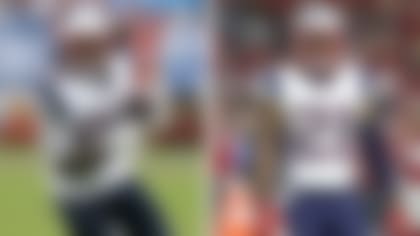Super Bowl LI will go down as one of the best title games in NFL history. The New England Patriots overcame a 25-point third-quarter deficit to knock off the Atlanta Falcons 34-28 in the first-ever overtime Super Bowl. Some have called it the ultimate choke job by the Dirty Birds. Others think it's the greatest comeback in recent memory. One thing everyone can agree on: Super Sunday delivered -- in a major way.
Now, I believe there were a few significant factors that helped Bill Belichick and Tom Brady bring a fifth Lombardi Trophy to New England. Given some time to review the All-22 Coaches Film, I've come up with three keys to the Patriots' epic win:
1) Tom Brady played like the G.O.A.T. in the clutch.
Say what you want about Brady, but there's no denying his ability to perform under pressure. Brady entered the game with the most game-winning drives in the playoffs in the Super Bowl era (nine), ahead of John Elway (six), Eli Manning (five) and Joe Montana (five). Most impressively, Brady had orchestrated game-winning drives in each of the Patriots' first four Super Bowl wins.
With that in mind, we certainly expected the veteran quarterback to eventually get back on his game after stumbling out of the gate in Super Bowl LI. Despite the fact that Brady led the Patriots to just three points in the team's first seven drives, you felt like it had to be only a matter of time before he cracked the code to the Falcons' defensive scheme.
Studying the first half of the game, I noticed that Atlanta's aggressive tactics and superb execution of Cover 1-Lurk completely disrupted the rhythm of the Patriots' passing game. With a deep-middle safety defending the post and the "high hole" defender (positioned at 10 to 15 yards in the middle of the field) jumping crossers, Brady was unable to throw to his sweet spots between the numbers. As an exceptional timing and anticipation thrower, Brady prefers to go down the seams on vertical plays and over the middle on intermediate routes. Thus, the location of the Falcons' help defenders eliminated a lot of Brady's favorite throws, particularly when the slot defenders played with proper leverage (outside shade) and funneled receivers inside to the designated robbers.
For example, the Falcons' flawless execution of Cover 1-Lurk led to Robert Alford's 82-yard pick-six in the second quarter. As you can see in the video just below, the Patriots motioned into a trips-bunch formation, with Julian Edelman (outside receiver) running a crossing route and Danny Amendola (inside slot receiver) following him on an angle route. With Atlanta safety Keanu Neal dropping into the hole, Alford passed off Edelman to the cutter and got his eyes back to Brady to get an early break on the throw, pick off the pass and stroll all the way to the end zone:
Brady obviously didn't expect Alford to be in the alley when he read man coverage prior to the snap, but the switch-off tactics built into the coverage made life difficult for the future Hall of Famer during the opening half.
After halftime, I noticed Brady started to work the outside part of the field to take advantage of one-on-one coverage. He frequently connected with Malcolm Mitchell on a number of deep hinge routes along the boundary. The rookie receiver not only worked over Jalen Collins and others on the route, but he became Brady's No. 1 target in key situations in the fourth quarter. By directing his passes to the boundary, Brady avoided throwing into brackets or double coverage while exploiting the biggest weakness of the coverage, as you can see here:
In addition, Brady started to work the underneath areas of the coverage with timely tosses to his running backs -- particularly James White, who recorded a Super Bowl-record 14 catches. The slippery RB is an exceptional route runner out of the backfield, especially on circle routes and swings from an off-set position. As the Falcons started to play more zone near the red zone and on long-yardage downs, Brady continually dumped the ball off to a moving target on a check-down. While those dink-and-dunk receptions didn't seem like much initially, Brady's patience and discipline targeting the underneath routes paid off handsomely as the Falcons attempted to sit in zones to rest a tired defense. With fatigued defenders unable to corral White in the open field, the catch-and-run strategy allowed the Patriots to stay in manageable situations for the balance of the second half.
Remember, the Patriots scored on four separate drives that covered 70-plus yards on 10 or more plays. Typically, that's exactly how NFL defensive coordinators want offenses to play, because it requires tremendous patience and discipline to drive the length of the field without a negative play to derail the drive. To his credit, Brady avoided the hero throw for most of the game and played "connect the dots" football in the late stages to sustain drives and get his team in a position to win the game late.
The best quarterbacks in the game not only make highlight-reel throws in key situations, but they exhibit the patience, poise and discipline to surgically pick apart a defense with an assortment of underneath throws when the coverage takes away deep shots. Brady again showed the football world that he is the best quarterback in the business by adjusting his game in the middle of the Super Bowl to attack a defense that played lights out for a little over three quarters.
And, of course, Brady did tack on another Super Bowl-winning drive -- this time in overtime -- and notch his fourth Super Bowl MVP.
2) Atlanta's game-management errors hurt in the fourth quarter.
As a young player in the NFL, I had a wise coach tell me that more games are lost than won in this league. The coach said that the mismanagement of crucial game situations, turnovers and penalties lead to losses in the biggest spots. These things definitely came into play in the Falcons' collapse on Sunday.
First things first: Play-count disparity was one of the key factors in the loss. The Falcons' beleaguered defense was on the field for 90-plus snaps (93 actual snaps, but 99 total snaps when factoring in penalties), and the resulting fatigue led to some defensive breakdowns. While some in the analytics crowd will tell you that time of possession doesn't matter, it's apparent the defense suffered mightily with the extra snaps. The pass rush disappeared late, with the D-linemen exhibiting rubber legs. Not to mention, the coverage loosened when the defensive backs lost their focus due to the mental and physical fatigue associated with playing man coverage for a high number of snaps. Prior to Sunday, the Falcons' defense had never played more than 81 snaps in a single game this season, which suggests the unit played beyond its breaking point in Super Bowl LI.
Now, some things are unavoidable and can't be blamed on coaching/game management -- like how Alford's pick-six meant that Atlanta's defense had to stay on the field for lengthy back-to-back possessions in the first half (26 consecutive snaps in total). Despite that oddball circumstance, the Falcons' offense could've aided the defense by milking the clock in the second half. While most observers have suggested the team should've run the ball more, Atlanta's failure to simply take the play clock under the five-second mark in the third and fourth quarters gave the Patriots extra offensive snaps.
On the subject of running the football, though: The Falcons should've made the run a big part of their strategy immediately after getting to the cusp of the red zone with less than five minutes remaining in the game. Julio Jones' insane catch gave Atlanta a first down at the Patriots' 22-yard line. If the Falcons had run the ball on three consecutive downs, they could've burned clock and set up a very makeable field goal (especially for the reliable Matt Bryant) to increase their lead to 11 points. That would've forced New England to face the daunting prospect of scoring a touchdown, converting a two-point attempt, securing an onside kick and swiftly driving into field goal range. This should've been enough to make the Falcons take a conservative approach with the game almost in hand. But after one run play (more on that below), they decided to throw the ball. A sack and a holding penalty later, Atlanta was out of field-goal range and had to punt.
One final point that I need to make: Atlanta's kick-return unit also played a role in the team's collapse. By trotting out the onside return team multiple times in the fourth quarter, the Falcons conceded valuable field position by catching the ball and running out of bounds deep inside their own territory. Although it didn't get a lot of attention at the time, the poor field position decreased Atlanta's odds of scoring and changed the play calling in critical moments.
3) The Patriots' defensive adjustments paid off in the second half.
Hats off to Patriots defensive coordinator Matt Patricia and Belichick for making key adjustments on the sideline to slow down the Falcons' high-powered offense in the second half. After watching the Dirty Birds race out to a 28-3 lead, the Patriots switched up their defensive tactics to get key stops at critical moments. The unit abandoned its conservative approach and attacked Matt Ryan with a few plays that disrupted the MVP's rhythm in the pocket.
For instance, the Patriots kept the Falcons from putting points on the board after an unsuccessful onside kick with two minutes left in the third quarter by dialing up a blitz on third-and-long. Kyle Van Noy and Trey Flowers combined for a sack on a simple five-man loop blitz that kept the Falcons out of field-goal range.
The Patriots used a similar blitz to help Dont'a Hightower get a free shot on the quarterback midway through the fourth quarter. The blitz not only caught Ryan off guard, but Falcons RB Devonta Freeman wasn't prepared for the tactic and allowed the big-bodied rusher to fly right by him:
That strip-sack completely changed momentum, giving New England an opportunity to make it a one-score game with plenty of time remaining.
From a strategic perspective, the Patriots also changed up how they defended the stretch-run play in the late stages of the game. In that critical fourth-quarter situation following the Julio Jones catch that we discussed above -- where the Falcons could've kicked a field goal and gone up 11 points -- the Patriots came out on first down playing Cover 1 with Devin McCourty positioned near the box as the deep defender. McCourty is typically assigned to the deep middle, but he inched toward the box, to the side of the slot receiver. When the Falcons ran their patented toss-crack play, McCourty enjoyed a clean run to Freeman and made a textbook tackle behind the line of scrimmage.
New England might've made these changes out of desperation, but the Patriots' decision to move outside of their comfort zone helped them get the critical stops needed to pull off a highly improbable comeback win.
Follow Bucky Brooks on Twitter @BuckyBrooks.











